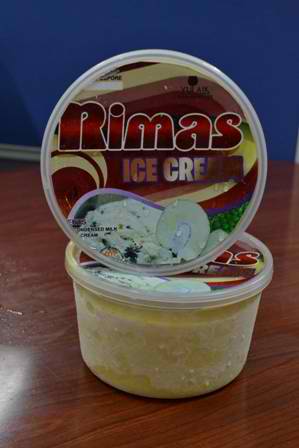Putting a twist to the conventional flavors of ice cream, the Department of Agriculture-Regional Field Office 5 (DA-RFO 5) through the Bicol Integrated Agricultural Research Center (BIARC) developed rimasflavored ice cream as part of their research and development (R&D) activities on rimas. The team proudly shared that 20 kilos of rimas ice cream were shipped to Hongkong for acceptability trials and to look for possible distributors. This was made possible through Global Mana, a company that focuses on food, energy, and water and once sponsored a breadfruit conference in Hawaii.

Rimas ice cream was first showcased and presented to the public during the 9th Agriculture and Fisheries Technology Forum and Product Exhibition held at SM Megamall, Mandaluyong City in 2013. Organized by the Bureau of Agricultural Research (BAR), the said event showcased generated technologies of various R&D institutions in the country. The rimas ice cream bagged an award as one of the innovative products during the said event because of its novelty, uniqueness, and market potential.
Interested to know more about rimas, Mr. Joshua Niel Echague of Global Mana came across to one of BAR’s published articles on rimas ice cream on the internet. Checking on the contact details, Mr. Echague contacted DA-BIARC and the Regional Agriculture and Fisheries Information Division which then endorsed the concern to the project team led by Ms. Luz Marcelino, research manager of DA-BIARC.
Growing abundantly in the Bicol region, rimas or breadfruit is one of the highest-yielding food plants, with a single tree producing up to 200 fruits per season. Recognizing its potential, BIARC embarked on a project titled, “Rimas Biodiversity Research, Conservation, and Propagation in the Bicol Region,” which was funded by BAR. Aimed at determining the biodiversity of rimas in the region, the project also intends to increase the awareness of the Bicolanos on rimas as an affordable and alternative source of essential nutrients.
“It is abundant in carbohydrates, and therefore can be a main source of energy. The fiber present in rimas is found to help the digestive system of our body,assisting in the digestion of food and helping reduce cholesterol levels,” Ms. Marcelino shared.
With abundant harvest and with the conventional notion of preparation of just boiling and being served as snacks, the harvests were left rotting. Value-adding activities were then developed by the team.
The Regional Food Laboratory of DA-BIARC is continuously undertaking researches on product development given the succulent endosperm present in the fruit. To date, 15 recipes were developed. These include rimas pastillas, rimas cheese cupcakes, rimas chips, rimas caramel, ginataang rimas, rimas fries, , rimas kimchi, torones de rimas, rimas cookies, rimas pork dumplings, rimas rice balls, rimas custard cake, rimas spring roll, rimas muffin, and rimas ice cream. Comprising 80 percent of rimas meat, ice cream now comes in three variants: rimas with sweet potato, rimas with cheese and chocolate, and rimas with langka. Other crops abundant in the region like siling labuyo, taro, and pili nut are also added in the mixture.
The processed 10 kilograms of rimas fruit will be packaged in one kg of ice cream that can be sold at Php 150. “If we could just meet the demand, we could process as much as 50 kilos thrice a week,” Ms. Marcelino said. These would also be parallel to the objective of helping farmers increase their income as sources of raw materials come from farmers in Tigaon, Camarines Sur and in Sorsogon.
Rimas ice cream gained high acceptance in terms of taste, aroma, texture, and appearance based on the product acceptability survey conducted. These can also be offered to cafes and restaurants given the increasing demand to innovative offerings.
“Rimas ice cream has a high potential because of its distinct flavor and we are using organically-grown ingredients,” Ms. Marcelino added.
The team acknowledges the BAR’s support to the development of products utilizing locally available crops. “With this undertaking supported by BAR, we were able to see the economic importance of this crop, which could also be in response to the goals of the DA of making food available and affordable; and increasing the income of farmers.Also, to be able to mainstream Gender and Development, we also give importance to empowering women’s role in farming and processing,” Ms. Marcelino said.
The local government of the six provinces in the region assisted the project in identifying farmers and rimas sites. There isalso the support from Sorsogon Dairy Farm who became the source of raw materials, and the Yulaik Food Company who helps in facilitating feedback surveys for product improvement.
Through propagation techniques (tissue culture and grafting), the project was able to maintain 100 plants inside the laboratory and 50 potted plants from tissue-culture technique and150 grafted rimas.
To date, BAR is supporting five projects on rimas covering benchmarking studies and researches on pest management, propagation techniques, and nursery establishment implemented by some DA agencies and state universities and colleges.
“We hope that there would be a consolidated effort on rimas. Also, I encourage fellow researchers to continue finding ways on how to utilize indigenous crops in our localities and collaborate with other research centers or networks for sharing of information, expertise, and future collaboration,” Ms. Marcelino concluded. ### (Ma. Eloisa H. Aquino)
Source: http://www.bar.gov.ph
